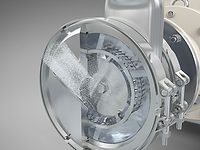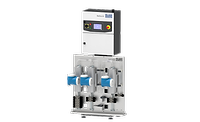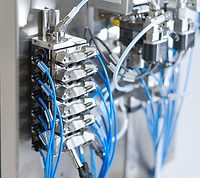A Unique Color Mixing System for Colored Wood Stains and Varnishes






The different types of wood, with their own specific characteristics such as age, density and tannin content, pose a challenge for all colorists. The tight cell structure of latewood can store more tannic acid, and therefore stains more intensely than earlywood.
The varying levels of color pigment penetration depth with their differing thickness, as well as numerous other factors, also have an effect on the staining result. The technological requirements for the dyeing of wood1 thus do not apply for wood.2 As a result, individual concentration series are required for each surface (with its specific properties) when calculating the stain color formulas, meaning the colorist must generate a large number of samples and possess a great deal of expertise. In addition, for each new wood that appears on the market, the color development process must be repeated, as it is not possible to use existing calibration series.
New Software
With the color formulation software Datacolor MATCH™ AFX, this process is simplified and shortened considerably. Production processes can be optimized quickly and easily. Within seconds, the perfect formula can be generated for colored wood stains or glazes. This saves an enormous amount of time, money and resources.
For Hesse-Lignal, a leading manufacturer of wood coatings, customer orientation has the highest priority. "To be successful in the market over the long run, it is absolutely necessary to develop products and services that focus on customers' needs," according to Beate Hesse, one of the three Manager Directors at Hesse-Lignal. "We guarantee quality and first-class service. Responding quickly to customers' needs is extremely important to us. Our cooperation with Datacolor in developing a color formulation system, which can simplify and shorten our color development process, is perfectly aligned with our goals. The long development time has definitely paid off. The use of Datacolor MATCH AFX results in a significant improvement throughout the entire process. We can thus react more quickly to color trends in the market and the needs of our customers."
The basis for the breakthrough was the development of a new formulation algorithm. SmartMatch technology has been used for years to greatly improve the quality of initial color formulation. It was only with the development of AxisSmartMatch, however, that it became possible to use this solution with great success for highly absorbent surfaces and translucent or transparent coatings. By using this technology, the number of samples needed to identify and calibrate the color on wood surfaces is reduced by up to 80%, leading to significant time and resource savings. The preparatory work is drastically reduced with a simultaneous improvement in accuracy and process efficiency. The ability to be able to describe the characteristics of surfaces (substrates), which influence the effect of colorants and thus the appearance, with so few color samples brings scientific accuracy to a process that was previously a process of trial and error. Hesse-Lignal and Datacolor have combined outstanding color measurement technology with color science and production expertise, thus developing the most exact and efficient color formulation solution for colored wood stains and glazes on various wood types. This solution is currently the only one of its kind worldwide.
Hesse-Lignal is convinced about the capabilities of this color formulation system. "We develop all of our formulas with MATCH AFX," confirmed Beate Hesse. "The software is even used in our depots. We developed a simplified SHOP version for this purpose together with Datacolor."
"The installation of the system in stores did not pose any problems, and our dealers now have far more options in relation to the provision of advice and the sale of wood stains and varnishes."
As a manufacturer, Hesse-Lignal – as well as their dealers in depots – can respond to individual customer needs and provide any desired color tone in the required quantity. Even repairs or additions are possible later on. The existing sample is measured using a mobile measuring device – this is completed directly on site for large or non-transportable items, such as cabinets or doorframes. Changes to the hue, which may arise due to different wood batches or aging, are taken into account during measurement. Afterwards, the measuring device is simply connected to a PC and the measurement is transferred with the click of a button. The desired hues can then be formulated and corrected. By directly controlling the paste mixing system, the stored hue cards can be dosed and corrected directly. The appropriate hue is then provided in the desired amount, with little effort. This is a service that customers value highly.
About Hesse-Lignal
Since setting up in 1910 Hesse-Lignal has produced lacquers and stains for interiors. Customers are industrial manufacturers as well as the companies from the carpentry trade. Their products are produced following the latest formulas and unite standardised quality with easy and safe processing. The company’s modern manufacturing plants enable the production of about 100 tonnes of lacquers and stains based on approx. 40,000 formulas every day. Hesse-Lignal employs approximately 450 employees and has a very extensive product range, solvent free as well as aqueous environmentally minded systems.
About Datacolor
Datacolor is a global leader in color management solutions and color communication technology. A Swiss-held company, Datacolor’s global presence encompasses a sales, service and support network serving customers in more than 65 countries throughout Europe, the Americas and Asia, along with 13 worldwide operation and production facilities. Industries served include apparel and textile, coatings, automotive, plastics, photography, digital imaging, home theater, ink, printing, paper, leather and others.
For more information, e-mail info@datacolor.com or visit www.datacolor.com.
Looking for a reprint of this article?
From high-res PDFs to custom plaques, order your copy today!












